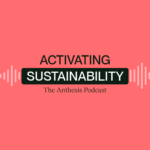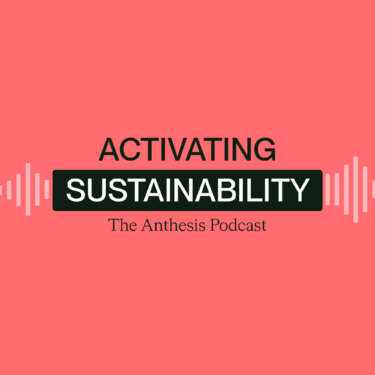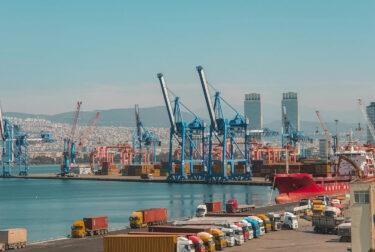
Speakers
Nita P. Woods – Host
Michael Lenaghan – Associate Director
Ceri Linton – Senior Consultant
Related Topics
- Read about Carbon Border Adjustment Regulations (CBAM)
Share this episode
In this Activating Sustainability episode, our host Nita P. Woods is joined by Anthesis Associate Director Michael Lenaghan and Senior Consultant Ceri Linton to discuss one of the most transformational recent pieces of legislation, the Carbon Border Adjustment Mechanism (CBAM).

Read the transcript
Nita: Hi, and welcome to the Anthesis podcast. I’m Nita P. Woods, I’m the Client Impact Director here at Anthesis, and I am your host today. Today, what are we talking about?
Well, it’s arguably the most exciting and powerful climate policy to be developed. It’s the carbon border adjustment mechanism, otherwise known as CBAM. And joining me today is Michael Lenaghan and Ceri Linton, who are two of our experts in the climate team leading on this complex tool. Thank you for joining us.
Michael: Pleased to be here. Thanks, Nita.
Ceri: Thanks, Nita.
Nita: You’re very welcome. So, Michael, in a nutshell, can you explain where this new regulation has come from and how the Carbon Border Adjustment Mechanism will disrupt the market?
Michael: Yeah, sure. So the CBAM has been developed by the European Union, and it’s meant to address an issue known as carbon leakage. So to understand where CBAM comes from, you really need to understand the ETS or the Emissions Trading Scheme which operates in the EU. And the idea of the ETS is the world’s largest cap and trade system for carbon emissions, and it means that if you’re an affected industry, you have to pay for your emissions if you operate in Europe. It drives decarbonisation across energy generation, as well as energy-intensive industries like cement and steel and aluminium and so on.
The problem with the ETS is that one way to avoid paying the carbon price is to buy materials from outside the EU where that carbon price is not in place, and that is carbon leakage. And it’s bad for the EU economy, but it’s also bad for the climate, because the EU is reducing its emissions, not by reducing global emissions, but by seeing those emissions pushed out to other regions of the world. And in some cases, if that production moves to more carbon-intensive countries, we could actually see a net increase in emissions.
So the CBAM has been brought in place in order to apply the same carbon price as the ETS to EU imports and therefore level the playing field and ensure that there’s no way to escape the carbon price.
Nita: Thank you, Michael. That sounds complex. Okay, so let’s get into the nuts and bolts of this, then. So to both of you, please talk me through what this actually means, like, what’s in scope? Who does this affect? Who would you want to be talking to when it comes to our clients and the people that work inside our clients?
Ceri: Yeah. So initially, CBAM will only cover certain goods and industries that are particularly high emitting industries and that are a higher risk to carbon leakage, as Michael explained. So the industries that are currently in scope are cement, iron and steel, aluminium, fertilizers, electricity and hydrogen. Within these groups, there are two distinct groups of clients that are going to be affected by CBAM:
The first is importers of CBAM goods into the European Union. This group of people are going to be required to report both the embedded emissions of their goods and the price of those goods.
The second group are the installations or the suppliers of the CBAM goods to those importers and they’re going to be requested by the importers to provide the data behind the emissions of their goods to support that reporting requirement.
Michael: I think because of the way that this affects both the importers, so the EU companies that are buying these goods, but also requires that their suppliers beyond the EU measure their carbon footprints of their products and supply that data. It’s really bringing carbon communication to the heart of global supply chains. And once the equivalent ETS price is applied, it’s going to drive decarbonisation across the globe. So, it is a really transformative policy tool. And I think the other really exciting thing about it, beyond the fact that the EU is going to be driving decarbonisation around the world, is that it also creates a really strong incentive for countries that currently don’t have a carbon pricing policy to implement one. Because at the moment with CBAM, what will happen is a carbon price will be levied and the money generated is going to go to the EU. If a non-EU country implements its own carbon price, it can pre-empt the CBAM taking into effect and retain the revenue gained from carbon pricing within its own economy to be spent on its own public services, decarbonisation, et cetera.
Nita: Okay, so if I’ve understood this correctly, importers of products that fall into these sectors are going to be asking their supply chains for the embedded carbon data. And if I’ve got that right, who do you want to be working with? Like what kind of people are going to be landed with this sort of responsibility? And if we have some examples, are we doing this for any clients at the moment or what kinds of clients would we be see doing this work?
Ceri: So we have started to work with operators of installations who are supporting their clients to report to the CBAM transition registry. And the way that we’re supporting them to do that is by helping them to understand and calculate the embedded emissions within their products. So, we’re leveraging both primary data from their sites and the default data that has been provided by the EU Commission to understand the embedded carbon in their products. As we go through the transition period of the CBAM policy, we’re going to be supporting them to move away from those default values and really understand the real-world emissions of their goods. And we really see this as a cascading system so that the importers can get a really granular visibility of their whole supply chain to be understand exactly where the carbon in their product sits and which suppliers that sits with.
Michael: Yeah. To build on what Carrie said, first and foremost the EU importers need to report the embodied impacts of the goods that they import, but also they need to report what the effective carbon price paid for those emissions are.
The CBAM is only going to leverage a price required to equal that of the ETS. So, if a carbon price is already being paid on the emissions of a good produced outside the EU, then they don’t want to leverage a price that’s too high and makes it uncompetitive. That means that in addition to recording your CBAM emissions, you also need to record your effective carbon price. And that means we also need to understand the carbon pricing policy in place in every country along that supply chain route.
In one of the examples that we’ve recently done with an installer, we found that the exposure risk is really quite high and could result in a price increase for their products of up to 10%. And that would really impact their competitiveness in the EU market, and just goes to show the risk that non-EU companies face when supplying the EU if they don’t start to decarbonise to reduce their CBAM risk.
Nita: Can you talk to me about this in really practical terms? Like is this just for big industry? Is this about steel beams that are used in construction or is it as little as a steel screw? Talk to me about actually the real impact that this has and who this really affects.
Michael: Sure. So for each of the industries covered by CBAM, there are a long list of what are known as CN codes. These are customs codes that importers use to declare what they’re importing to the EU. And any imported good that falls under these CN codes requires a CBAM report. So the emissions for that good must be reported, quantified, and then the price paid on those emissions communicated as well.
And this affects a huge range of products. They are all generally what we would call simple products. So they’re not complex multi-component products, they are simpler products like the ones you outlined, Nita. So it could be steel beams used in construction, it could be screws, it could be sheets of rolled metal, could be bags of cement. But it’s the sort of base materials which are then used in subsequent manufacturing processes and then used within the EU by manufacturers to produce the more complex goods.
Nita: What’s the time scales on this? I believe that there is some sort of grace period that we’re currently in, but talk to me about why this is important right now, today, when this podcast comes out.
Ceri: Yes, as you say, we’re currently in the transition period of the CBAM regulation, and importers of CBAM goods to the EU will be required to submit their first quarterly report on the 31st of January. So we’re really in like a last-minute rush to be able to get those first round of reports in. They’re going to be reliant really heavily on the default data, as we understand that importers aren’t going to be able to go back and look through their supply chain right now to be able to understand the embedded emissions in their products.
Then we’re looking at a transition period over the next two years where the importers won’t be asked to pay the carbon price for the imported goods. So, although they’re reporting both the embedded emissions and the carbon price, they won’t be subjected to any additional cost. That will change on the 1st of January 2026, where the cost of the carbon will then be implemented.
Another part of it is that as of July of this year, the importers will no longer be able to rely on that default data. So, they’ll be required to ask their operators to provide the actual real-world emissions data sets, and they will not be able to use default data for over 20% of the emissions that they’re reporting.
Nita: Whilst I recognize that what happens if a client, they are still using the default data, is it a slap on the wrist? Who’s checking and what are the implications for companies who don’t follow the letter of this regulation?
Michael: Yeah, so the precise financial penalties that are going to be involved are not yet clear, but there certainly will be cause for financial penalties if companies are found to be non-compliant with the reporting requirements. And that means if they’re using default data when they should have transitioned to primary data, or if they’re found to be inaccurately, whether well-intentioned or not, reporting the emissions of their goods, because this does have a material effect on the price that they will be levied against them under the CBAM.
And just to touch back on this timeline, I think what we’re looking at for the next ten months is everyone’s going to be scrambling to get their data together to get a handle on what their actual supply chain emissions look like and transition away from default data to primary data. Once they’ve made that transition, then they have a year and a bit to do everything they can to reduce the carbon impacts of their goods in order to ensure that when the price comes into play in January 1st of 2026, they are facing as little as possible because they’ve decarbonised as much as they can.
So first it’s data, then it’s decarbonisation, and it’s all going to be happening in the next two years. It’s a really exciting time to be involved in this and to be driving that real systemic global decarbonisation movement.
Nita: Yeah, it sounds it, Michael. So what I’m hearing from you and to try and perhaps summarise, is there does seem to be now a much stronger incentive to decarbonise, particularly for the non-EU producers. So, whilst CBAM is an EU regulation, it’s actually having a massive influence on the wider EU market. What does that mean practically for businesses? Sometimes regulation can feel a bit like a stick, but what’s the carrot side of it? What’s the real upside for businesses actually, who get their house in order quickly?
Michael: Yeah, it’s a great question. I think carbon pricing is not going away. It’s going to spread and it is going to spread to more sectors, more emissions, more countries. We’re moving to a world in which all carbon is priced. The EU has taken a real jump start at this, both first internally and now it’s pushing it out beyond its borders.
But companies that embrace this change and invest in decarbonisation now will maintain or gain access to EU markets as their competitors fall behind and don’t put in that effort. But they’re also going to be really well positioned to excel domestically when their own countries put in place carbon pricing and when other nations that they want to be selling their products into put in place carbon pricing.
So there’s nothing to be lost by moving quickly and moving fast to get into decarbonisation now. It’s a really sound investment for the future of manufacturing businesses.
Nita: Thank you, Michael. And so how can Anthesis help? What are the services and what are the types of work that we can support our clients with and future clients like this sounds an incredibly heavy lift for businesses that could have up to 200 plus EU customers and huge global supply chains.
Michael: Yeah. So the support that we would offer will vary slightly depending on whether you’re an EU importer and therefore the declarant or the one required to report to CBAM versus a non-EU manufacturer.
To take the first group, your first task is to identify all the goods that you import which fall under CBAM and then to get your report in for that. So you need to register with the CBAM authority and you need to use the EU default values to put in an estimate of the emissions embodied within those imports. And you need to do that on a quarterly basis. And then over the next ten months, you need to start engaging with your suppliers of those goods to start obtaining primary, or what we would call primary data or real-world data of those emissions. And that transition is going to be very data-intensive. There’s no easy way to put it. It is a lot of data crunching and data gathering that needs to happen. But once you’re in that position, once you’ve gotten over the finish line, then you just need to maintain that. It becomes a lot easier.
And it’s important to note that at the start, everyone’s starting from zero, but ten months from now everyone is going to be in the same position where they’re measuring their impacts and they’re reporting on them, including all of the global suppliers that are supplying goods into the EU. So they’re all scrambling in the same position. So we’re all moving together on this journey.
For the non-EU CBAM producers, their task is to start measuring their installation emissions. So the emissions that they generate at their production facilities when making these CBAM goods, they then need to attribute those to the goods that they’re selling and provide a report of that to each of their customers individually so that those can be incorporated into the CBAM report. They then need to turn and look backwards up their supply chain to the suppliers that provide them with raw materials or products that go into what they manufacture and do the same thing over, get the same installation emissions back down the chain.
And so that’s a really big task for them as well, and one that we can help with in both cases. So engaging with your suppliers, helping them gather that installation emissions data, putting it into the format that is required for CBAM reporting, and then helping you communicate that in a standardised way to your EU customers such that they can make easy use of it in their own CBAM reporting.
And we’re working with clients in both of those groups, the EU importers and the non-EU CBAM goods manufacturers.
Nita: That sounds like it’ll have a huge impact. And I think what I love hearing about actually is it’s not just that Anthesis can do the do, but actually together with our clients we can impact and influence not just the total reduction in carbon, but support our clients in cost efficiency and competitiveness in the market. So to summarise then, it sounds like Anthesis can help you audit the goods that fall under CBAM, use the default data to get initial numbers, then help collect the real data from the supply chain and do all the engagement and reporting. Is that right?
Michael: Yeah, that’s right. And I guess the last bit, the most exciting bit, is once you’ve got your data in order, then it’s time to turn to look at reduction and you’ll already have gathered all the data about where and why those impacts occur. So, we have really good data to use to then start identifying the hotspots and figuring out what changes can be made to bring those carbon impacts down. And Anthesis has a ton of expertise, whether it’s in energy decarbonisation and efficiency or in material sciences and the use of recycled content and lightweighting and so on.
But these are all the sorts of levers that CBAM goods manufacturers will need to be pulling in order to decarbonise their products and reduce their exposure to CBAM.
Nita: Thanks, Michael. So before we wrap up, Kerry, is there anything else that you’d like to add that we’ve not covered that you would really want our listeners to know about the CBAM regulation?
Ceri: I think just echoing it is the biggest and most transformational piece of legislation that we’ve seen recently. And to echo that it’s not just going to be the EU who are implementing a CBAM. The UK have already said that they’re going to be implementing a CBAM in 2027 with other countries to follow suit. So I think this is really the start of something much bigger and we’re going to be learning a lot of lessons from the EU implementation and that will be taken through into other regions.
Nita: That’s a really nice summary. And actually I just wanted to end on a quote from the European Commission who put out a statement that said “the EU’s carbon border adjustment mechanism, CBAM is our landmark tool to put a fair price on the carbon emitted during the production of carbon-intensive goods that are entering the EU and to encourage cleaner industrial production in non-EU countries.”
So really at the heart of know, we’re talking about real world, real reduction, real impact on our climate crisis. So on that note, Michael, if our listeners hear this and want to know more, where can I direct them?
Michael: Well, they can contact the anthesis inbound email or they can write to me directly. My email is michael.lenaghan@anthesisgroup.com. And I would very much like to hear from them as we’re really excited about helping clients get on track with CBAM. We live to drive impact and to make the world a more sustainable place, so we want to make the most of this opportunity.
Nita: Those emails and links will be in the show notes thank you both Michael and Ceri for joining me today. Thank you for listening to the Anthesis podcast. Check out the latest news and blogs on our website, anthesisgroup.com and we will be back next month for more sustainability insights.
Inside this episode
- CBAM’s objectives and origins,
- Which organisations are affected and the impact on global markets,
- Important dates and implementation timelines, and
- Why it is important to get ahead on CBAM now.
If you have any feedback on the podcast, get in touch with our host Chris Peterson at: Chris.Peterson@anthesisgroup.com















